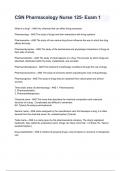CSN Pharmacology Nurse 125- Exam 1
What is a drug? - ANS Any chemical that can affect living processes
Pharmacology - ANS The study of drugs and their interactions with living systems
Pharmaceutics - ANS The study of how various drug forms influence the way in which the drug
affects the body
Pharmacodynamics - ANS The study of the biochemical and physiologic interactions of drugs at
their sites of activity.
Pharmacokinetics - ANS The study of what happens to a drug. The process by which drugs are
absorbed, distributed within the body, metabolized, and excreted.
Pharmacotherapeutics - ANS The treatment of pathologic conditions through the use of drugs
Pharmacoeconomics - ANS The study of economic factors impacting the cost of drug therapy.
Pharmacognosy - ANS The study of drugs that are obtained from natural plant and animal
sources.
Three basic areas of pharmacology - ANS 1. Pharmaceutics
2. Pharmacokinetics
3. Pharmacotherapeutics
Chemical name - ANS The name that describes the chemical composition and molecular
structure of a drug . Complicated and difficult to remember.
EX: Tylenol (N-acetyl-p-aminophenol)
Generic name - ANS name assigned by the manufacturer who first develops a drug; it is often
derived from the chemical name. Ex: acetaminophen (Tylenol)
Trade name - ANS Is a name given by the pharmaceutical company. The drug's registered
trademark. Also called the proprietary name. Drugs can Have more than 1 of these. Ex: Tylenol
(acetaminophen )
Drug classification - ANS A method of grouping drugs; may be based on structure or therapeutic
use.
,Enteric-coated tablets - ANS Have a special coating that allows them to pass through the acidic
environment of the stomach & dissolve in the more alkaline environment of the small intestine.
DO NOT CRUSH
Dosage Forms - ANS 1. Enteral: Tablets, capsulses, oral soluble wafers, pills, etc.
2. Parenteral: Injectable forms, solutions
3. Topical: Aerosols, ointments, powders, gels, patches, inhalers, rectal and vaginal
suppositories
Rate-limiting time - ANS Time necessary for drug to disintegrate and dissolve into the
bloodstream.
Drug has higher rate-limiting time and absorbs quickly if in a(an)
____________________environment. - ANS Acidic, children and elderly absorb more slowly
because their bodies are more alkaline.
Rate the rate-limiting time for the following drug forms from FASTEST to SLOWEST:
A- Powders
B-Coated tablets
C-Lipid soluble liquids, syrups, elixirs
D-Capsules
E-Enteric-coated tablets
F-Water soluble liquids, syrups, elixirs
G-Suspensions
H-Tablets - ANS C, F, G, A, D, H, B, E
What are the 4 phases of Pharmacokinetics? - ANS 1. Absorption
2. Distribution
3. Metabolism
4. Excretion
Absorption - ANS The movement of a drug from its site of administration into the blood.
Determines how quickly the drug will become therapuetic.
Bioavailability - ANS The percentage of the administered drug dose that reaches the systemic
circulation
Rate of absorption may be influenced by: - ANS 1. Food injested
2. Pain and Stress
3. Temperature
4. Exercise (increased circulation in body and decreased circulation in GI tract.)
, First-pass effect - ANS The initial metabolism in the liver of a drug absorbed from the GI tract
before the drug reaches systemic circulation through the bloodstream. Reduces the
bioavailability of the drug to less than 100%
Enteral routes - ANS Route of administration that uses the GI tract, such as swallowing a pill.
Types: Oral, Sublingual, Buccal, Rectal (can also be topical)
Parenteral routes - ANS Route of administration via a needle into the skin layers.
Intradermal- ID, Subcutaneous- SQ, Intramuscular-IM, Intravenous- IV
Topical routes - ANS Applied to the skin and mucous membranes.
Types:
Eye, nose, ear, respiratory and urinary tract, vagina, and rectum
Distribution - ANS Transport of a drug by the bloodstream to its site of action
IV route considerations - ANS 1. Fastest absorption because it enters bloodstream directly,
diluted with large fluid volume, and avoids first pass effect.
2. Needs careful monitoring for safe blood levels, watch for IV site infection, and length of time
the IV site can be used.
3. Higher cost, risk of infection, can't self administer, and irreversible.
IM/Sub-Q route considerations - ANS 1. Absorbed over a long period of time, but more rapid
than oral route, used with drugs that are poorly soluble, several drugs can be administered
simultaneously, if compatible.
2. Use anatomical landmarks to find injection sites and correct syringe/needle size.
3. Discomfort of injection, only small amounts may be given, risk of damage to blood vessels,
nerves, tissue.
Oral route considerations - ANS 1. Easiest, most convenient, least expensive. Safest route and
may be reversible in cases of accidental injection.
2. Take with 6-8 oz of water, for tube administration, line must be flushed before and after.
3. Slow, variable absorption, inactivated by stomach acid, goes through first pass effect, may
irritate stomach.
Sublingual/Buccal route considerations - ANS 1. Rapid absorption, avoids breakdown by
stomach and first-pass effect.
2. Small pills placed under tongue or in cheek.
3. Patient may accidentally swallow pill instead of allowing absorption
Rectal route considerations - ANS 1. Rapid absorption, good when oral route isn't feasible, less
first-pass effect.
2. Absorption can be erratic, discomfort and embarrassment for patient, higher cost than oral.




